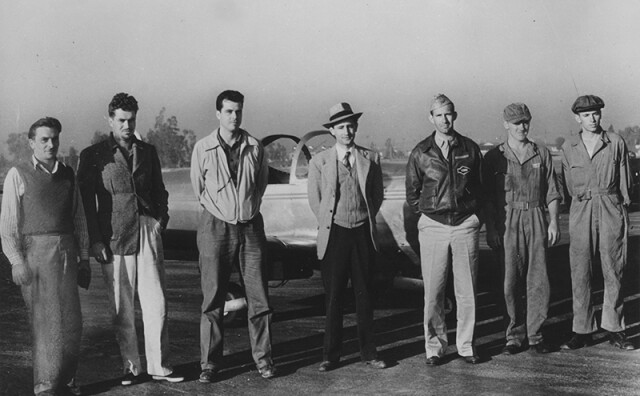How Phoenix Bakery (And Its Famous Strawberry Cake) Survived 80-Plus Years in Chinatown

If Youlen Chan could have found a machine capable of handling his baking tasks and techniques, he would have bought it in a hot second.
"I was trained in high production and I have not found a thing that could make our products to our expectations," the second-generation baker says as he stands inside Chinatown's Phoenix Bakery.
Its precise opening date is a mystery. Kathryn Chan Ceppi, daughter of one of the original owners and part of the second generation of the family that runs the bakery, is still sorting through records. The year, though, was 1938, when Chinatown's Central Plaza debuted. Ceppi's parents had migrated to the United States from Guangzhou in Southern China and her father, Fung Chow Chan, opened the bakery with support from her mom, Wai Hing.
They began producing traditional wintermelon pastries, seasonal moon cakes, almond cookies and their own creations. By the 1940s, Ceppi's uncle, Lun F. Chan (Youlen's father), who had studied baking in Hong Kong, joined the business as its head baker. The rest is sweet history.

It's A Family Affair
What we now know as Los Angeles's Chinatown wasn't the city's first such enclave. L.A.'s original Chinatown sprung up closer to Alameda and Cesar Chavez during the second half of the 1800s. Racist laws, including the Chinese Exclusion Act and the California Alien Land Law, prevented Chinese people from owning the land on which they lived and built their businesses. The first Chinatown was razed in the early 1930s, when Union Station was developed.
After that, the Chinese community pooled their finances to buy the land that would become today's Chinatown. Central Plaza, located between Broadway and Hill, had its grand opening on June 25, 1938.

Phoenix Bakery was originally located on Broadway then moved inside Central Plaza before ultimately settling into its Plaza-adjacent spot in 1977. On an exterior wall facing Broadway, you'll spot a large mural featuring the store's mascot, a young boy sheepishly smiling as he holds a package behind his back. It's the work of renowned artist Tyrus Wong, who was largely responsible for the look of the Disney film Bambi. His eight-decade career spanned animation, illustration and fine art before he died in 2016 at the age of 106.
Meeting with members of the second-generation of the Chan family, I learned about their history. In addition to Youlen and Kathryn, Kathryn's brothers Kelly and Ken are in attendance. All of them grew up at Phoenix.
"There were no nannies. There was no pre-school. No daycare," says Kathryn. When their parents were working, they were in the shop.
Kathryn worked in the front of the bakery, handling the display cases and cash register. The boys often worked in the back. Youlen remembers doing "whatever had to be done" — washing pans, cleaning strawberries, sweeping the floor. After a stint as an economics major, he began studying baking and ultimately took over the kitchen. Other members of the Chan family pursued various interests before returning to the fold. Kathryn is a retired pediatric occupational therapist. Kelly was an accountant for the IRS. Ken worked in several fields, including banking.

Pour Some Sugar On Me
In the kitchen of Phoenix Bakery, an employee ices the bakery's signature dessert, a strawberry whipped cream cake, its side exposed to reveal a layer of deep red berries and airy cream separating the double-deckers of sponge. Since Youlen's father developed the recipe in the 1940s, generations of Angelenos have fallen in love with it. And why not? It's a taste of Southern California springtime served year-round.
The Chan family says they often hear from people who have moved out of Los Angeles but make it a point to visit Phoenix Bakery for a slice of nostalgia whenever they're in town. Stop by on any weekend and you'll notice employees adorning cake after cake with birthday messages. On Mother's Day weekend, when the bakery is at its busiest, you'll see dozens of the cakes being boxed and sent off with eager customers.
Youlen thinks the strawberry cake is popular because it's not too heavy, satisfying without being a gut-buster. The berries and whipped cream add sweetness without the cloying aftertaste of many frostings. The cake is also understated in style, white with a splash of color — frosted pink or red rosettes — on top and a carapace of golden, slivered almonds around the sides.
"We were more of a cake that tasted good than a cake that was a showpiece," Youlen says.
When I was a child, the strawberry whipped cream cake was my favorite. After moving to Chinatown about five years ago, I was excited to know I could have a slice whenever I felt like it. Then I started eating my way through the rest of Phoenix's menu. Eclairs with cloud-like tufts of cream sandwiched between chocolate-topped pastry. Large brownies frosted with chocolate mousse. Crisp almond and sticky butterfly cookies. Then there are the savory buns with fillings like barbecued pork or the surprisingly addictive combo of jalapeño, pepperoni and cheese.
Phoenix Bakery's display case is a microcosm of Los Angeles, a home for sesame balls, baklava and tres leches cake, although the bakery's roots are in traditional Chinese pastries. Two treats remain a special source of pride. "We're one of the few, I think, that can truly say that moon cakes and wintermelon cakes — Chinese pastries — are made by hand," Kathryn says.

Also known as a "sweetheart cake" or "wife cake," the wintermelon cake relies on the wax gourd, common in Asia and also grown in the U.S. At Phoenix, the small, round pastry has a flaky crust that gives way to thick filling infused with the delicate flavored of melon. While other items have come and gone from Phoenix's menu, this traditional pastry has been served for as long as the bakery has been in existence.
In September, the Phoenix rolls out its annual supply of moon cakes. These delicacies are only offered around the Mid-Autumn Festival, held in connection with the full moon in late September.

"You buy it and you bring it to your friends, relatives and you use them as gifts for the moon festival," says Kathryn. "You have tea and the moon cakes. It's a tradition that's been handed down from generation to generation."
Phoenix's moon cakes are made using wooden molds that were purchased in China decades ago and feature imported duck eggs in the filling.

Sweet Emotion
In the mid-20th century, before shopping malls mushroomed across America, Chinatown was bustling. "This was a very touristy area," says Kelly Chan. Inside the bakery, the family could expect to stay late, sometimes after midnight. "We didn't close until the last person was gone," says Kathryn.
The neighborhood was also a gathering spot for the Chinese-American community. "For some younger generations, they may have their parents or grandparents living in Chinatown," says Ken Chan. "On the weekends, they would come here and take them for dim sum or for lunch or dinner, do their shopping and then go home."

As Southern Californians moved into the suburbs and Chinese-American communities sprung up in the San Gabriel Valley, Orange County and other locations, Chinatown became less of a cultural and tourist hub. "We've seen it change because many of the people just don't come here anymore," Kathryn says. More recently, she and her family have begun to see another shift.
With new residential developments in the area, Kathryn has noticed people moving back to Chinatown from downtown L.A. and other neighborhoods. Chinatown has also built up a calendar of food and music events. The combination of factors is returning the neighborhood to its mid-20th century role as a day-tripping destination for Angelenos. What does that mean for Phoenix Bakery? The Chen family isn't sure.

Neighborhood revivals can bring new customers but they often lead to rising rents, displacement of longtime residents and significant changes to the character of an area. For now, the shop continues to forge its path with a mix of traditional and on-trend desserts. Even as the surrounding neighborhood changes, you can count on big, fluffy birthday cakes filled with strawberries and covered with whipped cream.
-
Restored with care, the 120-year-old movie theater is now ready for its closeup.
-
Councilmember Traci Park, who introduced the motion, said if the council failed to act on Friday, the home could be lost as early as the afternoon.
-
Hurricane Hilary is poised to dump several inches of rain on L.A. this weekend. It could also go down in history as the first tropical storm to make landfall here since 1939.
-
Shop owners got 30-day notices to vacate this week but said the new owners reached out to extend that another 30 days. This comes after its weekly swap meet permanently shut down earlier this month.
-
A local history about the extraordinary lives of a generation of female daredevils.
-
LAist's new podcast LA Made: Blood Sweat & Rockets explores the history of Pasadena's Jet Propulsion Lab, co-founder Jack Parsons' interest in the occult and the creepy local lore of Devil's Gate Dam.









